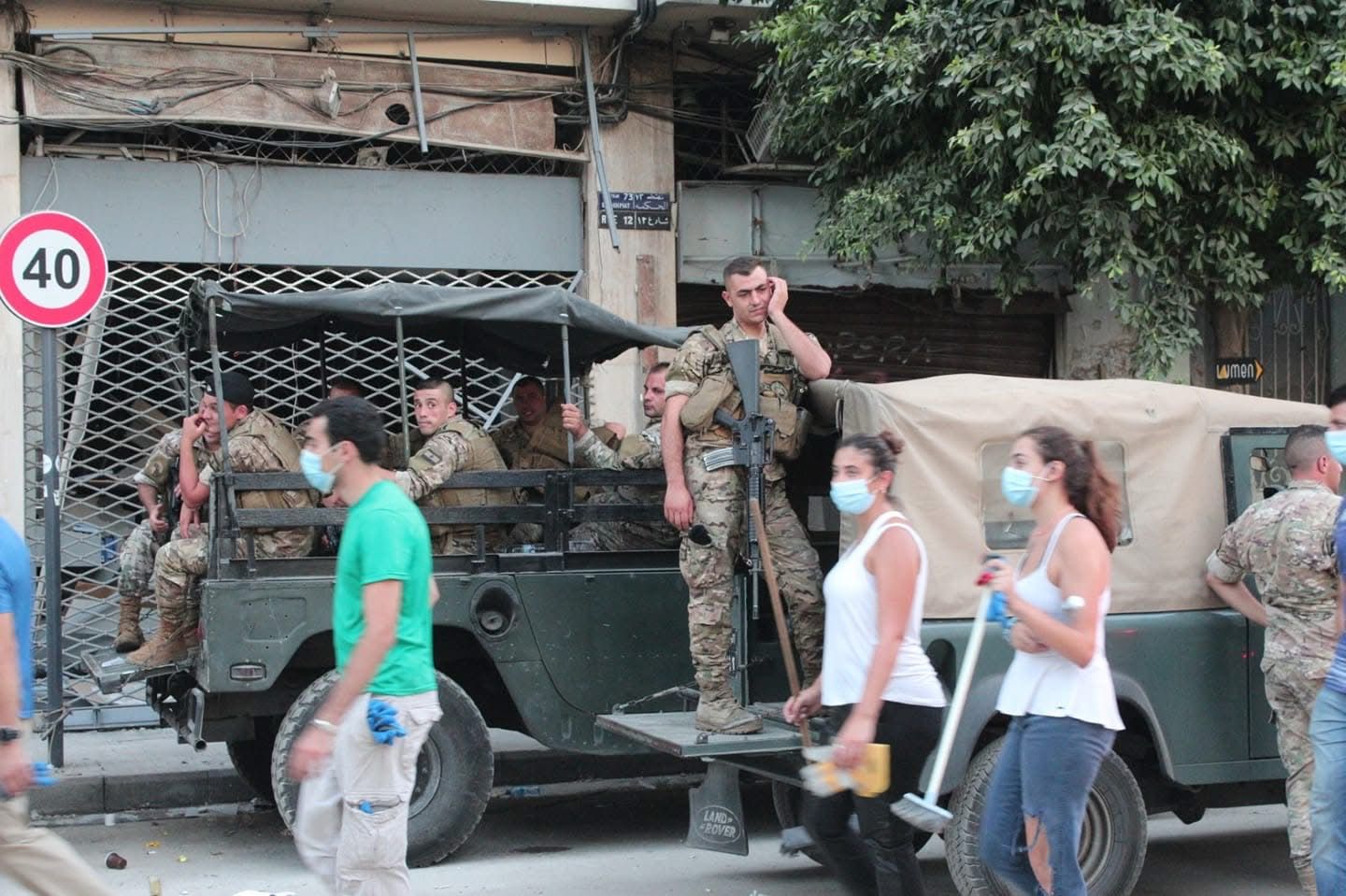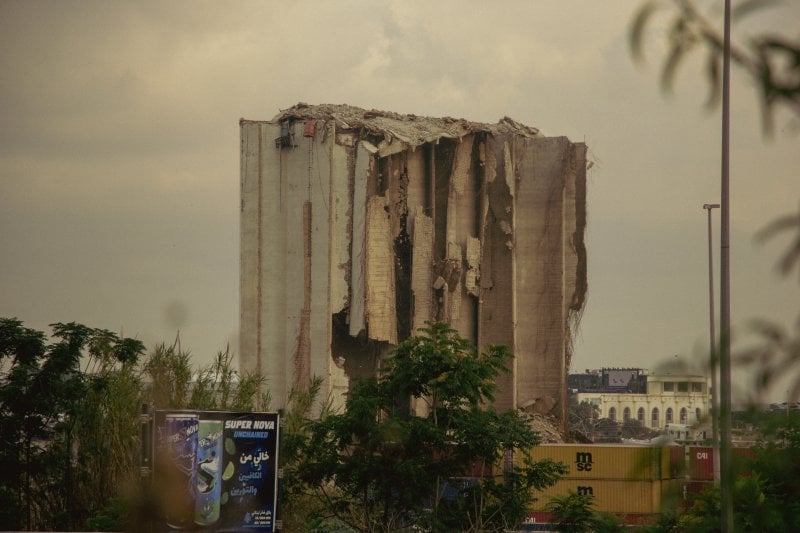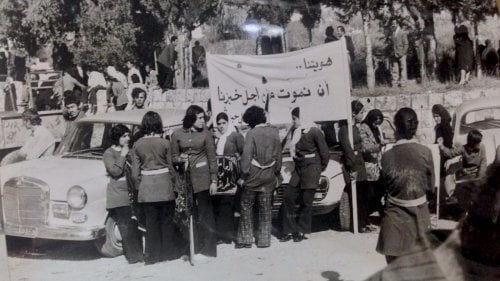I always hated the first day of rotations in a new hospital. I had to learn the ins and outs of another area, where to drive, where to park, master the layout of Lebanon’s labyrinthine hospitals, learn the staff’s codes and abbreviations, wrestle with yet another user-hostile computer system, and worst of all, memorize dozens of new names.
August 4th, 2020, was one of those days. After the confusion and strain of the day, the long drive home to Mount Lebanon felt endless. I only wanted my hour of solitude before asking how my family’s day went.
I started dozing off as soon as I sat at my desk. Then I heard a rumble, probably Israeli jets, a sound we had grown used to. A split second later, my family’s ancestral home shook as a loud bang tore through the stillness of that hot summer day. Then came the screams.
My sister ran up from her art studio in a panic: “We were bombed, Israel bombed us!” My mother, more composed, perhaps because of a childhood spent in Lebanon’s Civil War, was trying to account for everyone.
The news started pouring in: “an attempt on Saad el Hariri’s life in Qoraytem,” then “a storage of fireworks exploded at the Beirut Port.” Minutes later, videos of the ominous red mushroom cloud over Beirut were looping on all channels. The sight filled me with dread. Was that a nuclear bomb?
I decided to speed to the hospital in Beirut, where I had been previously posted. Surely they would need help, I thought. Little did I know how much help was needed.
Five years after the largest non-nuclear explosion shattered buildings and lives, we are no closer to an answer. The truth now seems out of reach. Confidence in the state institutions conducting the investigation is gone. If a verdict is ever reached, it will likely be narrow in scope, the penalties cosmetic, and the judgment so contested and polarizing that it would not matter.
The convoluted story behind the port blast is enough to push anyone toward conspiratorial thinking. The events of the past two years have also radically changed what counts as implausible after witnessing years of covert conspiracies come into the open.
Piecing it together
People were strewn across the street leading up to the Emergency Department. I threw on my white coat and an N95 mask and pushed through the crowd. The closer I got, the denser it grew, along with the screams of pain and shouts of frantic relatives. I spotted a colleague and asked who was leading the emergency response.
“No one,” she said. “Just pick a patient and start helping.”
There was blood everywhere. I caught snatches of people talking.
“Israel dropped a bomb.”
“I swear I heard a plane.”
“How could fireworks cause that?”
The convoluted story behind the port blast is enough to push anyone toward conspiratorial thinking. The events of the past two years have also radically changed what counts as implausible after witnessing years of covert conspiracies come into the open.
I tried to separate patients from health workers. Gauze, suture threads, scissors, syringes, and bags of saline, all passed by anonymous hands over people’s heads.
Then I saw the woman who would take all my attention for the rest of the night. She sat motionless in a chair, her face, hair, and arms soaked in blood, one eye swollen shut, the other barely open. I pulled shards of glass from her hair and face, wiping away caked blood to reveal shredded skin, suturing what I could. The more glass I removed, the more wounds appeared. It took hours before she was sent home.
Five years later I cannot recall her name, but I have not forgotten her pleading stare.
Outside, just past midnight, the streets were empty. I tore off my mask to breathe the cool air, which left a strange tingling in my throat. My sister, who had come to donate blood, met me and said, “They’re saying it was all an accident. Some explosive chemical in the port blew up.”
Between tears and hysterical laughter, I started screaming.
Rumors between the rubble
I spent the next day clearing rubble in the most devastated parts of the city.
Security forces stood every few meters across the shattered city. Their Humvees idled beside cars crushed by falling boulders while people with brooms and shovels trudged by. Whenever someone raised their voice in outrage at our collective fate, they sprang to life like toy soldiers wound up by an invisible hand, only to slip back into inertia when the shouting stopped.
Theories and counter-theories swarmed the streets. What was ammonium nitrate doing in the port? Who brought it here? Who kept it? Was it meant for militias in Syria, or was it a Hezbollah weapons depot? Could welding really start a fire like that? And would a fire alone detonate ammonium nitrate? What about the sound of a military jet seconds before the blast? Was it air rushing from the explosion, or was there truly a plane? What about the video showing a projectile falling into the hangar? Maybe it was a bird, or was it doctored?
It struck me then how one could blame anyone, the Hassan Diab government, the post-war sectarian system, Hezbollah, Israel… The identity of the culprit would not be a point of contention so long as we kept our voices down.
 Citizens clean up the streets as the Lebanese Army keeps watch. August, 2020. (Sirine Germany/Raseef22)
Citizens clean up the streets as the Lebanese Army keeps watch. August, 2020. (Sirine Germany/Raseef22)
Citizens clean up the streets as the Lebanese Army keeps watch. August, 2020. (Sirine Germany/Raseef22)
Fiction for history
The arrangement that ended Lebanon’s Civil War shaped the post-war era: facts were prohibited, but conspiracy theories were allowed. On August 26th, 1991, the Lebanese government issued the General Amnesty Law No. 84/91, forgiving all crimes committed by militias, armed groups, and profiteers during the war.
The Committee of the Families of Kidnapped and Disappeared rejected the amnesty agreement, knowing it would let criminals evade responsibility for the fates of 17,000 missing people. Desperate relatives clung to any theory provided by war profiteers to keep hope alive.
The arrangement that ended Lebanon’s Civil War shaped the post-war era: facts were prohibited, but conspiracy theories were allowed.
Conspiracies offered the bereaved equal parts comfort and suffering. A loved one might still be alive, or at least they died for a reason, or perhaps a culprit might someday face justice. Meanwhile, they suffer from being denied the release of grief and the ability to mourn, stuck in a past that cannot be revived. That is why, in 2005, when 11 bodies from the Yarze mass grave were identified through DNA, some families refused to accept them. They believed the government had conspired to falsify the results, and their loved ones were still alive in Syrian prisons.
Lebanon’s ruling elite, all products of violent wartime social ascent, favor theories over facts. Facts reveal the ordinary, often petty nature of sectarian leaders parading as divine figures. It took careful work to convince people that Lebanon had “always been this way,” with leaders who “inherited” power, nepotism being more tolerable than outright usurpation, which might inspire others to try the same. That illusion of eternity crushes the collective political imagination and is therefore protected at all costs.
That is why, in 2005, when suspicions rose about a mass grave in Majdal Anjar, authorities quickly closed the case, declaring the bones from an ordinary cemetery, despite families’ doubts. Five years later, in Shbaniyeh, officials insisted remains found on church grounds were those of animals, even as witnesses described human skulls wrapped in plastic. In 2009, journalist Alec Collett’s remains turned up near Aita al-Fakhar, but there was no broader search for other missing people there. When remains were uncovered in Mdoukha in 2023, the National Commission for the Missing learned about it through the media. This routine—minimal transparency, slow follow-up, and little urgency—left fertile ground for distrust and conspiracy theories to fill the gap.
Between 2004 and 2013, bombs regularly exploded in shopping centers, busy streets, and hotels, killing civilians and officials, mostly from what used to be called the March 14 bloc. To this day, none of these bombings has a credible, evidence-based answer. Only one investigation, into Prime Minister Rafiq Hariri’s assassination in 2005, was ever concluded. The Special Tribunal for Lebanon took a decade, cost 1 billion dollars, and was widely criticized from its mandate to its composition, proceedings, and final judgment.
In 2005, when 11 bodies from the Yarze mass grave were identified through DNA, some families refused to accept them. They believed the government had conspired to falsify the results, and their loved ones were still alive in Syrian prisons.
Even when the facts were numerical and undeniable, as with the 2019 economic collapse, Lebanon’s elites fell back on the same conspiratorial framing to dodge responsibility. One camp blamed an Iran-backed plot to get Lebanon sanctioned, the other agreed there was a conspiracy but pointed the finger at the United States instead.
The port explosion was a turning point. The destruction of half the capital posed political hurdles too big for the usual evasions. The damage was impossible to downplay. As Lebanon’s only truly multi-sectarian city and its economic center, the blast could not be neatly framed as one sect attacking another, though attempts were made.
The persistent advocacy from the multi-sectarian families of the Beirut Port Blast victims kept empathy alive, even if they were later broken by relentless sectarian pressure. When the old recipe for exploiting conspiracy theories did not work, the regime had to try overt manipulation on every front: media, political, legal, and security. It took substantial schemes, lies, and threats to stretch the Minister of Interior, Mohamad Fahmi’s investigation from five days to five years.
So far, limited investigations have only raised more questions. The story is a tangle of shady international dealings: a Moldovan-flagged ship owned by a Russian operator, overloaded with ammonium nitrate from Georgia supposedly bound for Mozambique, forced to dock in Beirut when its hatches buckled. Behind it was a British shell company tied to Russian, Ukrainian, and Syrian businessmen, with financing traced to a Lebanese-owned Cypriot bank sanctioned for money laundering. Meanwhile, Lebanese officials kept this lethal cargo in the port for years, dodging accountability through contradictory customs records, bureaucratic loops, and judicial evasions. What ignited the chemical remains unsettled. The dominant story, that welding sparked the fire, has not yet been verified.
Consolidating fiction as fact
As recent events have exposed the capabilities and complexities of covert operations, the boundaries of what is considered plausible have shifted dramatically during the past two years.
Hamas organized and launched a complex military operation from inside Gaza’s open-air prison. Israel, reportedly aware of these plans a year in advance, invoked the Hannibal directive on October 7th, worsening the death toll, then manufactured atrocity narratives like the infamous “40 beheaded babies” and “8 burned babies.”
From October 8th onward, Israel’s level of apparent preparation was staggering. It unleashed genocidal policies, making Gaza uninhabitable, and even encouraging the spread of disease. Later, it came out that Israel was using the AI system Lavender to build its kill lists.
When Hezbollah entered the war in support of Gaza, the day after the attack, its leader, Hassan Nasrallah, believed he controlled the ladder of escalation, until Israel played its real hand. Having infiltrated Hezbollah’s communications and database of safehouses and weapons depots, Israel detonated thousands of rigged pagers and walkie-talkies on September 17th, 2024, in a terror attack. Israel then assassinated Hezbollah’s top commanders, destroyed many of its safehouses, and worked with the US to craft a ceasefire it would keep violating.
Looking back, the assassination of Hamas leader Ismail Haniyeh in Tehran and the suspicious helicopter crash that killed President Ebrahim Raisi in May 2024 now seem like early warnings of what was to come.
As soon as that ceasefire took effect, an obscure Salafi leader, Mohamad al Jolani, led Turkish-backed forces in a surprise assault on Aleppo. The Syrian army chose not to fight, suggesting pre-arranged deals. By December 8th, Assad’s regime had fallen. Israel moved quickly to destroy key Syrian Army sites, setting the country’s military infrastructure back half a century.
More recently, Israel ran the same playbook in Iran. After misleading Tehran into believing nuclear talks with the US were ongoing, it activated Mossad sleeper cells that disabled Iranian air defenses and launched drones from within Iran. Israel then located and assassinated Iran’s top Revolutionary Guard commanders and nuclear scientists. Looking back, the assassination of Hamas leader Ismail Haniyeh in Tehran and the suspicious helicopter crash that killed President Ebrahim Raisi in May 2024 now seem like early warnings of what was to come.
The rapid succession of these events, each more destabilizing than the last, makes it difficult to maintain a clear sense of what is real and what is constructed. As buried operations surface and implausible claims prove true, the line between fact and fiction begins to blur. It is no longer irrational to feel disoriented or even conspiratorial. It is a response shaped by a region where history keeps outpacing belief.
Truth is a choice
It is fair to say Israel’s regional successes have been intelligence triumphs. The intricate conspiracies it wove over the past decade have paid off, even when its military campaigns faltered. These operations have dramatically stretched the boundaries of what we can imagine conspiracies might achieve and how complex they might be.
Perhaps now more than ever, many in Lebanon suspect Israel of triggering the port blast. The means are clear: unmatched intelligence networks, military capabilities, a proven record of complex covert operations, and a disregard for international law. The motives are there too, given how Hezbollah ultimately bore most of the political fallout, which it compounded itself by blatantly obstructing the investigation.
As for opportunity, Israel’s control of Lebanon’s skies is undeniable: 22,000 air violations were recorded between 2007 and 2021. More recently, drones have joined the tally of violations, becoming a regular fixture in both Lebanon’s airspace and soundscape, their hum a constant signal that we are being watched, and that danger is always near.
It is dangerous to discuss this theory openly because it may sound like exonerating Lebanon’s state and security officials for storing ammonium nitrate in a densely populated area. But there is little difference between setting up a bomb and setting it off.
As buried operations surface and implausible claims prove true, the line between fact and fiction begins to blur. It is no longer irrational to feel disoriented or even conspiratorial. It is a response shaped by a region where history keeps outpacing belief.
One might think that if Israel truly were involved, Lebanese leaders would have shouted it from the rooftops. But such an accusation would have carried implications none could bear. Those opposed to armed resistance feared the blast could rally support around Hezbollah’s weapons, while Hezbollah would have no choice but to go to war against Israel. Examining Israel’s involvement too closely was, therefore, in no one’s interest.
It is a peculiar feeling to realize that one’s life is forfeit simply by being born in the global South. The Beirut port blast reminded us of that, and the past two years hammered it in. Our lives are not only expendable, but worth less than others. This knowledge settles differently: for most, a quiet nihilism; for others, a daily struggle to rage against the dying of the light. Whether in rage or resignation, all cling to theories in search of meaning where none is offered.
To be Lebanese is to live in a self-constructed world of theories, because dying for a reason is somehow slightly better than getting killed by accident.
Raseef22 is a not for profit entity. Our focus is on quality journalism. Every contribution to the NasRaseef membership goes directly towards journalism production. We stand independent, not accepting corporate sponsorships, sponsored content or political funding.
Support our mission to keep Raseef22 available to all readers by clicking here!
Interested in writing with us? Check our pitch process here!







